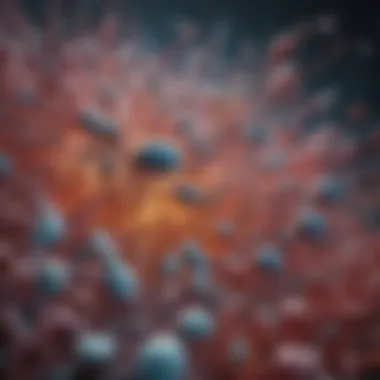Understanding Antibiotic Microbial Resistance and Its Impact


Intro
Antibiotic microbial resistance is not just an academic topic; it's a pressing issue that affects healthcare systems worldwide. With the misuse and overuse of antibiotics, a scenario has unfolded where bacteria have adapted and developed mechanisms that render these life-saving drugs less effective. The ramifications are far-reaching, impacting everything from individual health outcomes to global public health strategies.
As we dive into this in-depth analysis, it’s crucial to highlight that resistance is not a matter of simple bacteria versus antibiotics. It involves a tangled web of interactions influenced by various factors, including patient behavior, healthcare practices, environmental conditions, and, fundamentally, biological factors. Each of these elements contributes to a more nuanced understanding of how resistance develops and spreads.
In recent years, researchers have uncovered specific pathways and mechanisms that bacteria use to resist antibiotics. These discoveries illuminate the biological intricacies at play and serve as a crucial foundation for developing new treatment strategies and public health policies.
In the forthcoming sections, we will dissect the core mechanisms of antimicrobial resistance, explore the contributing factors, and analyze the current strategies employed to combat this formidable challenge. Ultimately, this exploration aims to equip readers with a comprehensive view of the ongoing battle against antibiotic resistance, underscoring the necessity for immediate action and informed policy-making.
"We are on the cusp of a post-antibiotic era, where common infections and minor injuries can kill." - World Health Organization
In essence, understanding antibiotic microbial resistance is not merely an academic endeavor; it is an urgent call to preserve the effectiveness of the antibiotics that remain viable today.
Understanding Antibiotic Microbial Resistance
Antibiotic microbial resistance (AMR) has evolved into a significant public health challenge. It stands as a testament to the dynamic and often adversarial relationship between humans and bacteria. By gaining insight into AMR, we equip ourselves with the knowledge required to navigate and combat this issue effectively. Delving into AMR allows us to understand not just the fundamental biology behind bacterial survival mechanisms, but also the broader implications these have on healthcare practices, societal norms, and environmental factors.
In this section, we will take a closer look at AMR's definition and its historical context, focusing on the intertwined narratives that inform our current understanding. This exploration paints a clearer picture of the factors at play in AMR dynamics.
Definition and Overview
Antibiotic microbial resistance occurs when bacteria evolve or acquire the ability to resist the effects of drugs that previously worked against them. To put it simply, it’s like teaching bacteria how to dodge a well-aimed bullet. This phenomenon illustrates a fundamental biological survival instinct—bacteria are not passive entities. Instead, they actively adapt to their environments, particularly when these environments include antibiotic agents.
When antibiotics are used, sensitive bacteria are killed off, while those resistant to the drug can survive and multiply. It's important to understand that resistance isn't just about one isolated incident." It’s akin to a rabbit being chased by a fox; if that rabbit learns how to evade the chase, it can pass those skills to its descendants. Understanding AMR's definition involves a recognition of both genetic flexibility and external pressures that nurture resistance.
Key Points on AMR:
- Bacteria can acquire resistance through mutations or by sharing genes with other bacteria.
- The misuse and overuse of antibiotics creates environments where resistant strains thrive.
- AMR is a universal issue, transcending geographical boundaries.
Historical Context
The history of antibiotics runs parallel to the tale of resistance. Penicillin was discovered by Alexander Fleming in 1928, a breakthrough that promised a new dawn in infection control. However, this magic bullet was not allowed to shine unchecked. By the 1940s, just a decade after penicillin's introduction, reports of penicillin-resistant Staphylococcus aureus began surfacing, pulling the alarm on what we now know as AMR. Many felt this was merely a hiccup, but it became clear that this was just the tip of the iceberg.
Fast forward to the late 20th and early 21st centuries, and a plethora of resistant strains emerged, including vancomycin-resistant Enterococcus and multi-drug resistant Mycobacterium tuberculosis. The reality that had once seemed distant was now a pressing concern.
In the midst of this historical backdrop, several trends can be noted:
- Over-prescription of antibiotics: Doctors, under pressure to treat patients quickly, sometimes prescribe antibiotics even when they aren't necessary.
- Agricultural practices: The agricultural industry's heavy reliance on antibiotics to promote growth in livestock has exacerbated resistance issues.
- Global travel and trade: The ease of movement across borders allows resistant strains to spread quickly and widely.
The tale of AMR is thus deeply rooted in medical and societal histories, shaped by our actions and, too often, our inactions. Understanding this context provides instrumental insight into why vigilance is critical in addressing AMR as a multidimensional public health challenge.
"If we do not act now, we will be faced with a post-antibiotic era, where many infections will revert to being lethal."
By grasping both the definition and history of AMR, we are not only acknowledging the task at hand but also preparing the ground for strategic responses that could change the tide.
Mechanisms of Resistance
Understanding the mechanisms behind antibiotic microbial resistance is fundamental in grasping this pressing health crisis. Resistance mechanisms not only illuminate how bacteria evade the effects of antibiotics but also highlight the challenges faced in the healthcare industry. Each mechanism sheds light on unique biological traits and adaptations that bacteria develop, which can lead to increased treatment failures, prolonged hospital stays, and complicated infections. Recognizing these mechanisms is crucial for developing targeted strategies to combat resistance effectively.
Genetic Mechanisms
Horizontal Gene Transfer
Horizontal gene transfer refers to the process whereby bacteria can acquire genetic material from other bacteria, rather than from parents. This transfer can occur through various methods such as transformation, transduction, or conjugation. Such a mechanism fundamentally alters how antibiotic resistance spreads, allowing organisms to quickly gain resistance genes from their peers instead of evolving these traits themselves. The key characteristic here is its ability to transmit resistance traits rapidly between differing species, which can lead to swift population-wide resistance. Its inclusion in this discussion about resistance mechanisms is all about its potency in fast-tracking resistance development.
One interesting feature of horizontal gene transfer is the adaptability it affords bacteria. For example, a single resistant strain can spread its resistance traits to an entirely different bacterial species, creating a more extensive problem than previously anticipated. On the downside, this rapid transmission can sometimes result in unintended consequences, such as creating highly resistant strains that are harder to control.
Mutation and Selection Pressure
Mutation and selection pressure are other vital factors contributing to antibiotic resistance. Mutations occur as bacteria reproduce and can occasionally lead to changes that confer resistance to antibiotics. In a setting where antibiotics are overused, resistant strains can become the dominant form due to selection pressure.
The most important aspect of this mechanism is its natural occurrence within bacterial populations. Mutations happen randomly; however, when antibiotics are introduced, those random changes can provide an undeniable advantage, allowing resistant strains to outlive their susceptible counterparts. This aspect of mutation and selection pressure is a critical topic for this article, as it underscores how easily resistance can emerge in clinical settings.
A unique trait of this mechanism is its reliance on environmental factors, particularly the misuse of antibiotics. When antibiotics are prescribed unnecessarily, the resistant strains of bacteria survive and proliferate, leading to a steep rise in resistance. While mutations are a natural part of microbial existence, their consequences can be dire when coupled with inappropriate antibiotic use.
Biochemical Pathways
Biochemical pathways are another layer in the complex dance of antibiotic resistance. These pathways refer to the biochemical processes that bacteria utilize to resist the effects of antibiotics, allowing them to thrive despite therapeutic interventions.


Enzymatic Degradation
Enzymatic degradation is a prime example of this pathway, whereby bacteria produce enzymes that can inactivate antibiotics. For instance, beta-lactamases are enzymes that can break down penicillin and its derivatives, rendering them ineffective. This critical characteristic of enzymatic degradation is that it serves as a first line of defense against well-known antibiotic classes, making it essential to include in this analysis.
The unique feature of this mechanism lies in its specificity; different bacteria produce different enzymes that target various antibiotics. This specificity can trap healthcare providers in a vicious circle, as they may switch to other antibiotics that can then be targeted by another enzyme. Its advantage in terms of survival for resistant bacteria is clear, but it also poses challenges for maintaining effective antibiotic regimens.
Alteration of Target Sites
The alteration of target sites serves as another defensive maneuver against antibiotics. Through genetic changes, bacteria can adapt the binding sites that antibiotics target, rendering the drugs ineffective. The primary characteristic of this mechanism is its stealth; it allows bacteria to survive without necessarily requiring enzymatic action. Instead, it changes the very components that antibiotics aim to disrupt.
This mechanism's distinct feature is its ability to confer resistance against multiple classes of antibiotics simultaneously. Altered target sites can lead to broad resistance, thus complicating treatment strategies. While it can be advantageous for bacteria, the complexity it introduces into healthcare complicates an already tricky landscape in antibiotic management.
Structural Changes in Bacteria
Structural changes in bacteria further illustrate the depth of resistance capabilities. Bacterial cell walls and membranes can adapt over time or in response to drug pressure, impacting how they interact with antibiotics.
By understanding mechanisms of resistance, health professionals can devise innovative tactics to combat the threat posed by resistant bacteria. The complexity of these mechanisms requires comprehensive approaches from multiple angles.
Contributing Factors to Resistance
Understanding the elements that fuel antibiotic microbial resistance is crucial for addressing this pressing challenge. These factors span various sectors, from healthcare practices to agricultural methods and environmental influences. Delving into these underlying contributors not only reveals the complexities of resistance development but also points out potential intervention strategies.
Antibiotic Overuse in Medicine
Prescription Practices
Prescription practices play a pivotal role in the management of antibiotics. This includes not only the types of antibiotics doctors choose to prescribe but also their decision-making process regarding whether a prescription is even necessary. Many healthcare professionals may feel pressured to prescribe antibiotics even in cases where they may not benefit the patient, often due to expectations from patients. A study shows that up to 30% of antibiotic prescriptions are unnecessary, contributing significantly to the growing problem of resistance.
Moreover, the characteristic of quick fixes associated with antibiotic prescriptions can be alluring, especially for patients seeking a rapid solution to their ailments. However, therein lies a trap; such practices may lead to a cycle of dependency on these medications, which compromises their efficacy over time. Each unnecessary prescription not only increases the likelihood of resistance development but also diminishes public confidence in antibiotic treatments overall.
Patient Compliance and Misuse
Patient compliance and misuse represent another significant piece of the resistance puzzle. Even when prescribed correctly, many patients fail to complete their antibiotic courses or misuse medication by sharing it or self-medicating. This behavior stems from various factors—ranging from a lack of understanding of the necessity of completing a course to the influence of cultural beliefs or misinformation about antibiotics. It’s alarming to think that 50% of antibiotic prescriptions are not taken as directed, leading to incomplete treatment and potential for resistance to emerge.
The unique feature of patient misuse lies in its persistent nature across age groups. This creates a challenge in managing resistance. Yet, addressing this issue could lead to better outcomes through education and awareness campaigns that emphasize the importance of proper antibiotic usage.
Agricultural Practices
Use of Antibiotics in Livestock
Agricultural practices, particularly the use of antibiotics in livestock, have significant implications for resistance. Farmers often employ antibiotics not only to treat sick animals but also to promote growth and prevent disease in healthy ones. This practice is widespread and has been shown to create resistant strains of bacteria that can transfer to humans through the food chain.
The use of antibiotics in livestock highlights the key characteristic of over-utilization. Some studies indicate that nearly 70% of the antibiotics sold in the United States are for livestock use. This high volume raises flags because it indiscriminately exposes bacteria to antibiotics, creating ideal conditions for the development of resistance. While it can enhance short-term yields for farmers, the long-term impacts on public health are severe and far-reaching.
Impact on Environmental Microbiomes
The impact of agricultural antibiotic use extends beyond the farm; it disrupts environmental microbiomes. These antibiotics find their way into the soil and waterways, affecting the natural balance of microbial populations. Such disruption can lead to a proliferation of resistant genes in microbial communities.
Highlighting this characteristic sheds light on a sobering reality: the impact of antibiotics used in agriculture can change not just human health, but also the ecological health of environments. The unique feature here is the interconnectedness of ecosystems and health; what happens in agriculture doesn’t remain isolated. Efforts to mitigate this influence necessitate collective action, emphasizing sustainable practices in farming.
Environmental Influences
Pollution and Contaminants
Pollution and contaminants are lurking dangers contributing to antibiotic resistance. Wastewater from hospitals and agricultural runoffs introduce not only antibiotics but also resistance genes into the environment. With most treatment plants not equipped to adequately filter these substances, they seep into natural water systems, creating reservoirs of resistant bacteria.
The characteristic of pollution impacting resistance is often overlooked. Compounding factors, like industrial discharges and urban waste, also play a role in this concerning scenario. As a result, natural habitats become conducive to the spread of resistant strains, highlighting an urgent area for intervention, especially in urbanization efforts and waste management.
Water Systems and Waste Disposal
Water systems and waste disposal have become another battleground in the fight against antibiotic resistance. Improper disposal of medications leads to contamination of groundwater and surface water, exacerbating resistance issues. Improperly treated sewage frequently contains high levels of antibiotics, which further enhance the proliferation of resistant bacteria.
This unique feature of water systems underlines a critical gap in existing waste disposal methods. Communities must reevaluate how waste is managed, emphasizing the importance of rigorous treatment processes to prevent contamination. Efficient waste management and community education about proper disposal are essential to curb this side of the resistance problem, calling for collaborations across environmental and health sectors.
In essence, tackling antibiotic resistance requires a comprehensive understanding of the contributing factors that span multiple domains. The responsibility lies not just in healthcare, but in agricultural policies and environmental management as well.
Impacts of Antibiotic Resistance
Understanding the impacts of antibiotic resistance is essential in framing its overarching significance in public health and societal well-being. This section dives into various facets, including the increased strain on health systems and the economic burdens it introduces. Often overlooked, these consequences are pivotal to addressing the overall challenge presented by antibiotic resistance.


Public Health Implications
Increased Morbidity and Mortality
The rise in antibiotic resistance correlates strongly with increased morbidity and mortality rates. In simpler terms, as bacteria become resistant to previously treatable infections, the likelihood of prolonged illness and death rises sharply. These realities are not just statistics but have tangible effects on individuals’ lives and their families.
A distinctive feature of this aspect is that it adds a layer of complexity to what are often considered non-lethal infections, turning them into significant health threats. The pressing characteristic of increased morbidity is that it emphasizes the urgent need for effective treatment protocols. Hence, recognizing this aspect presents a crucial choice for this article, as it ties directly into the need for informed health policies and stewardship.
"Antibiotic resistance doesn't merely affect the person who becomes ill; it creates waves that impact communities at large."
Increased mortality rates also shed light on healthcare inequities, as vulnerable populations often bear the brunt of resistant infections. This can lead to disadvantages in healthcare delivery, making it imperative to integrate discussions on morbidity into broader health conversations.
Healthcare Costs and Resource Allocation
An essential consideration in the context of antibiotic resistance is the growing healthcare costs and the subsequent resource allocation crisis it creates. The relentless battle against drug-resistant infections necessitates extended hospital stays, more complex treatments, and, often, additional medications. As these costs proliferate, they place an immense burden on public healthcare systems around the world.
The importance of this aspect lies in how it forces stakeholders to rethink their resource allocation strategies. A fundamental characteristic of rising healthcare costs is that it not only detracts from other necessary health services but also cripples preventative programs. Addressing these expenditures highlights a beneficial direction for this article by connecting antibiotic resistance with the economic viability of healthcare systems.
The unique challenge here is striking a balance between providing immediate care and ensuring sustainable health policies. It's a delicate tightrope where failing to manage costs effectively pulls resources away from critical areas like education and prevention, which could ultimately mitigate the problem in the first place.
Societal Consequences
Impact on Healthcare Systems
The impacts on healthcare systems are far-reaching, presenting a multitude of staffing and resource challenges. Healthcare providers face an uphill battle in managing the influx of patients who suffer from resistant infections. When hospitals are bypassed due to overcrowding, the overall quality of care diminishes, leading to unfavorable outcomes for patients.
A striking element is the role of antibiotic resistance in exacerbating existing flaws within healthcare systems, such as unequal access, which can lead to an unmanageable demand for specialized care. This aspect serves as a significant point for this article by directing attention to the urgent need for reform to bolster healthcare infrastructures against such threats.
Moreover, the unique interplay between patient care and antibiotic stewardship creates a double-edged sword. The challenge lies in not only addressing current patients but simultaneously managing the broader implications of antibiotic misuse.
Global Health Security Issues
Antibiotic resistance is not just a localized or national problem; rather, it poses a substantial risk to global health security. The proliferation of resistant pathogens knows no borders, threatening global populations and potentially leading to pandemics.
One key characteristic of this issue is that it magnifies the interconnectedness of global health initiatives, emphasizing the need for collaborative approaches in research and public health interventions. The global nature of drug resistance frames this discussion as a powerful choice for this article, as it underscores the urgent call for international cooperation in combating resistant strains.
The unique feature here is that tackling global health security issues can thus become a rallying point for nations to unite under a common cause. It brings to light the disadvantages that one region's negligence can have on others, making the conversation about antibiotic resistance a global imperative that transcends individual nation’s policies.
Strategies to Combat Resistance
Antibiotic microbial resistance is not just a technical term learned in a classroom; it has rippling effects in our daily lives. Tackling this issue takes more than just throwing more drugs at it; it involves a marshalling of strategies that can stem the tide of resistance. Understanding these approaches provides a framework for action that healthcare professionals, researchers, and policymakers can leverage. Each strategy plays a crucial role in managing and ultimately reducing resistance in both human and animal populations.
Stewardship Programs
Optimizing Antibiotic Use
Optimizing antibiotic use targets the heart of the problem. It focuses on prescribing the right antibiotic at the right dose for the right duration. A key characteristic of this approach is its emphasis on tailored therapies rather than broad-spectrum antibiotics. By limiting exposure to unnecessary antibiotics, healthcare providers can reduce the selective pressure that drives resistance.
This method is not just a beneficial choice; it's essential. Tailoring antibiotics according to specific infections ensures that patients receive effective treatment while minimizing collateral damage to beneficial bacteria.
However, this approach can have its shortcomings. Sometimes, doctors may not have the complete picture of a patient's condition right away, leading them to prescribe a broader antibiotic unnecessarily, fearing complications.
Monitoring Resistance Patterns
Monitoring resistance patterns provides crucial data that can steer treatment strategies more effectively. Knowing which bacteria are resistant or susceptible allows healthcare providers to make informed choices about antibiotic prescriptions. This key characteristic makes monitoring one of the most beneficial strategies, as it creates a real-time feedback loop for clinicians and public health officials alike.
Through this approach, the dynamic of antibiotic use shifts from a one-size-fits-all model to a more evidence-based practice. Among its unique features is the ability to spot emerging resistance trends before they escalate into public health crises. However, it does require sustained commitment and resources to implement effectively, often hampered by budget constraints.
Development of New Antibiotics
Innovative Research Approaches
Innovative research approaches are vital in the quest for new antibiotics. This category comprises everything from exploring alternative molecular targets in bacteria to leveraging natural products from microbes. The ability to come up with fresh solutions through such research is a significant boon to this article's discussion—offering hope in an era where many previously effective drugs are losing their punch against resistant pathogens.
The uniqueness of this feature lies in its collaborative nature, sometimes blending various scientific disciplines such as chemistry, biology, and even artificial intelligence, pushing the boundaries of what’s possible. Still, the path is fraught with challenges, as developing new antibiotics is a long and costly endeavor, with many candidates failing during the development phase.
Partnerships Between Academia and Industry
Partnerships between academia and industry represent another promising angle for addressing resistance. These collaborations can fast-track the translation of laboratory discoveries into viable treatments available in the market. They are beneficial because they combine the innovative spirit of academic research with the operational capabilities of the pharmaceutical sector.


A unique feature of these partnerships is that they can leverage resources from both sides, minimizing risks and amplifying knowledge. However, one must tread carefully, as these partnerships can sometimes lead to conflicts of interest, pushing for profit over public health in antibiotic development decisions.
Alternative Therapeutics
Phage Therapy
Phage therapy involves the use of bacteriophages—viruses that infect and kill bacteria—to combat bacterial infections. This method is particularly intriguing because it targets specific bacteria, offering a level of precision that traditional antibiotics can't match. Its uniqueness comes from the fact that phages can adapt and evolve alongside bacteria, making it a potentially sustainable option in our ongoing battle against resistance.
While this alternative has been gaining attention, it isn't without disadvantages. Phage therapy hasn’t been widely adopted in many countries due to regulatory hurdles and limited clinical data. Still, its promise is undeniable, and the ongoing research may change the landscape of treatment for bacterial infections.
Immunotherapy
Immunotherapy represents another avenue to counter antibiotic resistance. Typically associated with cancer treatments, this approach can be applied to infectious diseases as well. It seeks to harness the body’s immune system, enhancing its ability to fight infections. This characteristic makes immunotherapy an attractive option, as it not only aims at eradicating bacteria but also fortifying the body’s defenses against future infections.
The uniqueness of immunotherapy lies in its goal to prevent infections rather than just treating them. However, the research is still in relatively early stages, and there are concerns around its effectiveness across different population groups.
By weaving these strategies together, scientists and healthcare professionals can gain a multifaceted approach to tackle antibiotic microbial resistance. Each strategy holds promise, though they also come with their own sets of challenges. The necessity of comprehensive action, informed by best practices and innovative research, is crucial to address this pressing public health crisis.
Future Directions in Research
As the specter of antibiotic resistance looms larger, it becomes increasingly evident that future research efforts must be directed towards innovative solutions and enhanced understanding. This section will shed light on future research directions, primarily focusing on the roles of the microbiome and emerging technologies. Both areas possess immense potential in unraveling the complexities of microbial resistance and developing effective countermeasures.
Understanding the Microbiome
The microbiome, the diverse community of microorganisms residing in and on our bodies, is turning out to be a key player in the narrative of antibiotic resistance. Each person’s microbiome harbors trillions of bacteria, including both pathogenic and beneficial strains. Understanding how these microbial communities function can provide insights into resistance mechanisms.
Research demonstrates that a balanced microbiome can help in preventing infections and mitigating the effects of antibiotic treatments.
Highlighting its importance, research indicates:
- Dysbiosis: An imbalance in microbial populations can lead to increased susceptibility to infections, paving the way for conditions like Clostridium difficile.
- Resistome: This is the collective pool of resistance genes found in the microbiome. Understanding the resistome can help identify how resistance spreads among different bacteria.
This knowledge can guide the development of targeted therapies, potentially utilizing probiotics to restore a healthy microbiome, thus improving patient outcomes. In essence, future studies focusing on the microbiome could yield promising avenues for combating antibiotic resistance effectively.
Emerging Technologies
The rapid advancement of technology also holds promise in the fight against antibiotic resistance. Among these, Genomics and Bioinformatics stand out, offering transformative strategies to tackle the issue head-on.
Genomics and Bioinformatics
Genomics, the study of organisms’ complete set of DNA, paired with bioinformatics, which involves using computer science to analyze biological data, present a potent combination for addressing antibiotic resistance.
This approach allows researchers to analyze vast amounts of genetic data to identify resistance genes across various bacterial strains. The key characteristic of this technology lies in its ability to:
- Analyze genetic material rapidly: This not only speeds up the understanding of resistance patterns but also aids in detecting outbreaks of resistant strains more effectively.
- Predict therapeutic efficacy: By understanding the genomic makeup of pathogens, researchers can tailor antibiotics that are more likely to be effective against specific bacteria.
However, while the advantages of genomics and bioinformatics are apparent, challenges remain. The interpretation of large datasets can be complex and requires significant expertise. Moreover, the ethical implications of genetic data usage must not be overlooked.
AI in Drug Discovery
Artificial Intelligence is steadily becoming a pivotal player in drug discovery, and its application within the domain of antibiotic resistance cannot be overstated. AI essentially synthesizes complex datasets to predict relationships between bacterial genes and their resistance mechanisms.
The key characteristic that positions AI as a game-changing tool is:
- Predictive analytics: AI models can analyze historical data on antibiotic interactions and predict how new compounds will behave.
One unique feature of AI in drug discovery is its ability to sift through mountains of data from clinical trials, patient health records, and prior research much faster than traditional methods, allowing for swifter identification of potential solutions.
Importantly, AI can also assist in drug repurposing—finding new uses for existing medications, potentially reducing the time and cost associated with developing new antibiotics from scratch.
Yet, there are downsides, too. Overreliance on algorithms can lead to biases if the underlying data is poor or unrepresentative. Moreover, ethical concerns surrounding patient data privacy must be carefully addressed.
"The promise of tomorrow's technologies shines brightly. It is upon us to harness them wisely and ethically."
Epilogue
Antibiotic resistance is not just a medical quagmire but a widespread crisis we can no longer afford to overlook. This complex subject has far-reaching implications affecting everyone—from healthcare practitioners to ordinary citizens. Understanding this issue is vital for fostering a proactive attitude towards infection management and public health at large.
Recap of Key Points
As we draw our exploration to a close, let’s take a moment to recap the salient points:
- Definition and Mechanisms: We started by discussing what antibiotic microbial resistance is and delved into the mechanisms by which bacteria evade the effects of these vital medications. Mechanisms like genetic mutations and horizontal gene transfer play a crucial role in this ongoing battle.
- Contributing Factors: The role of antibiotic overuse in both healthcare settings and agriculture was highlighted. Misuse and non-compliance, along with the impacts of pollution, underscore how multi-faceted this problem is.
- Impacts: The implications of resistance extend to public health, with increased morbidity and mortality, and significant economic burdens on healthcare systems. These effects are compounded by societal challenges, making the fight against resistance a global priority.
- Strategies for Combatting Resistance: Effective stewardship, innovative drug discovery, and alternative therapies emerged as critical strategies. Understanding our own role in these initiatives can be a game changer.
- Future Directions: Research aimed at leveraging new technologies, like AI in drug discovery, promises exciting developments in the fight against resistance.
Call for Global Action
As we face this uphill task, it's clear that no single entity can tackle antibiotic resistance alone. A global call to action is essential to combat this crisis effectively. Governments, healthcare organizations, and individuals alike must take responsibility. Here are some steps we can consider:
- Policy Frameworks: Countries must enforce stricter regulations on antibiotic prescriptions and agricultural use.
- Education and Awareness: Public campaigns can raise awareness of antibiotic resistance, advocating for responsible usage among patients and healthcare providers.
- Collaboration: Shared knowledge and initiatives between countries can strengthen global efforts. There’s strength in numbers when it comes to tracking resistance patterns and developing new treatments.
In essence, fighting antibiotic resistance requires a multifaceted approach. Through collective effort, we can pave the way towards a future where infections treatable again, ensuring a healthier planet.
By reinforcing these elements within our healthcare systems and communities, we can stand against this emerging threat. The time to act is now, and every effort counts.







